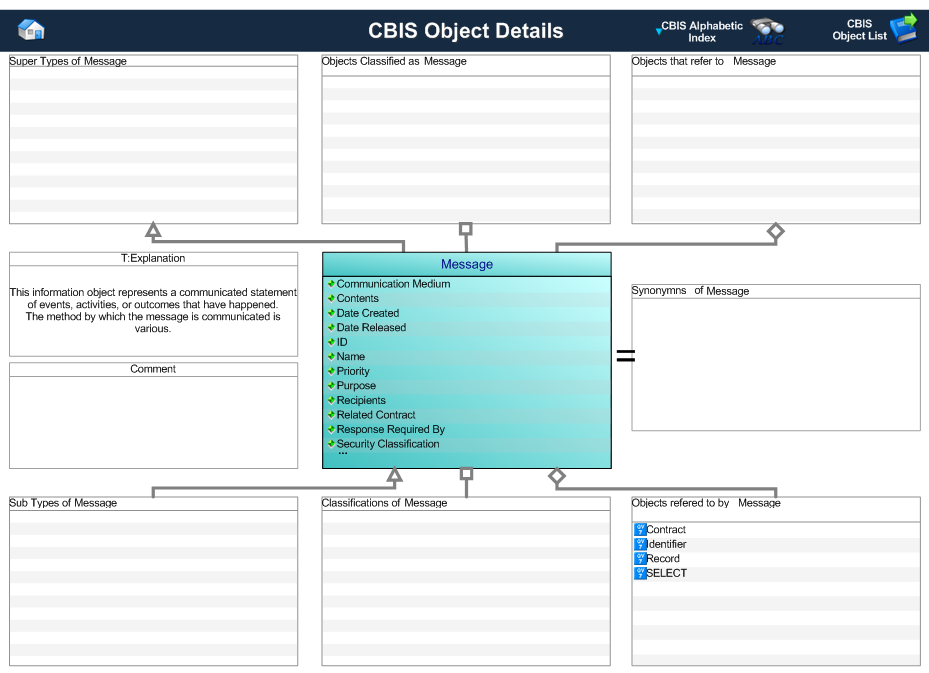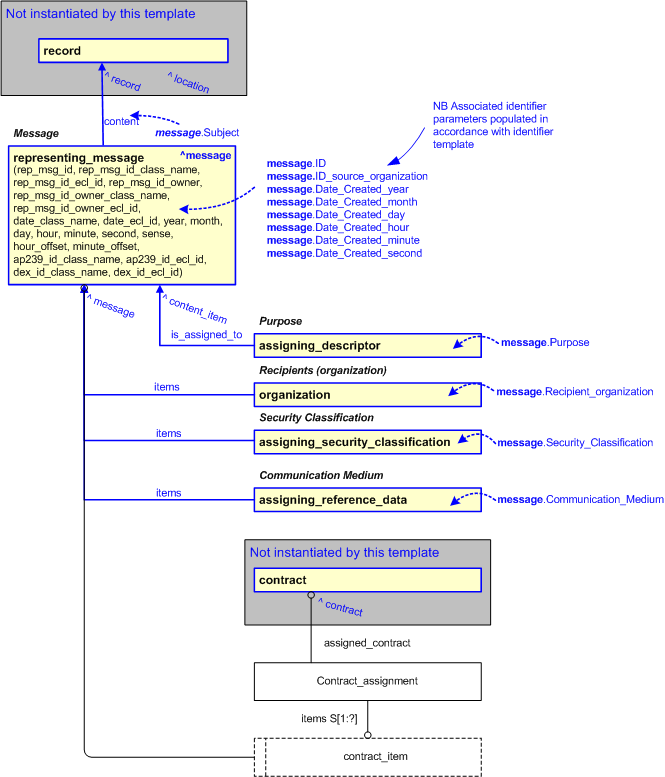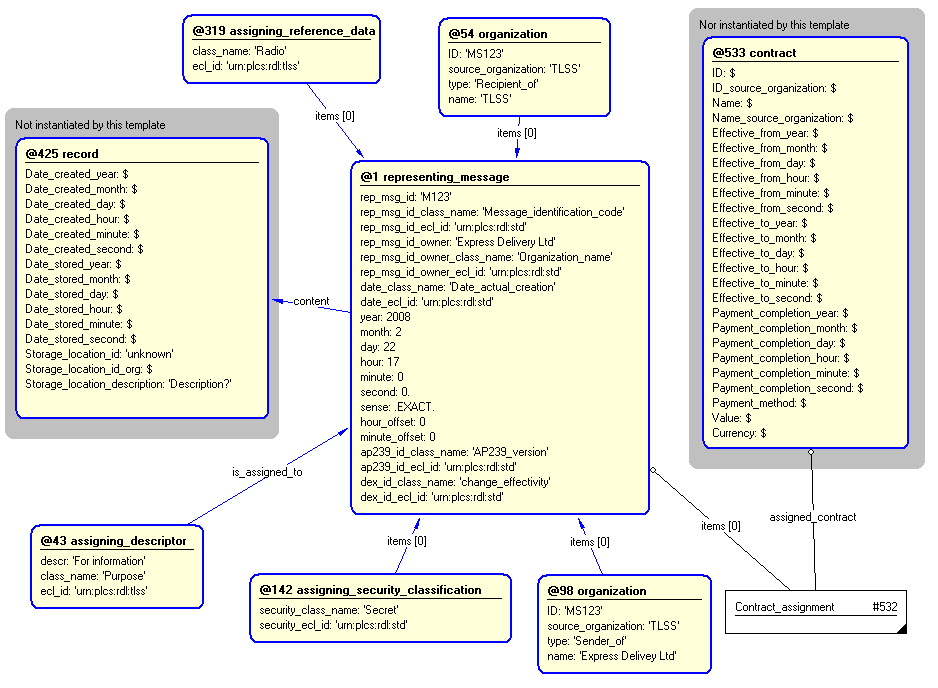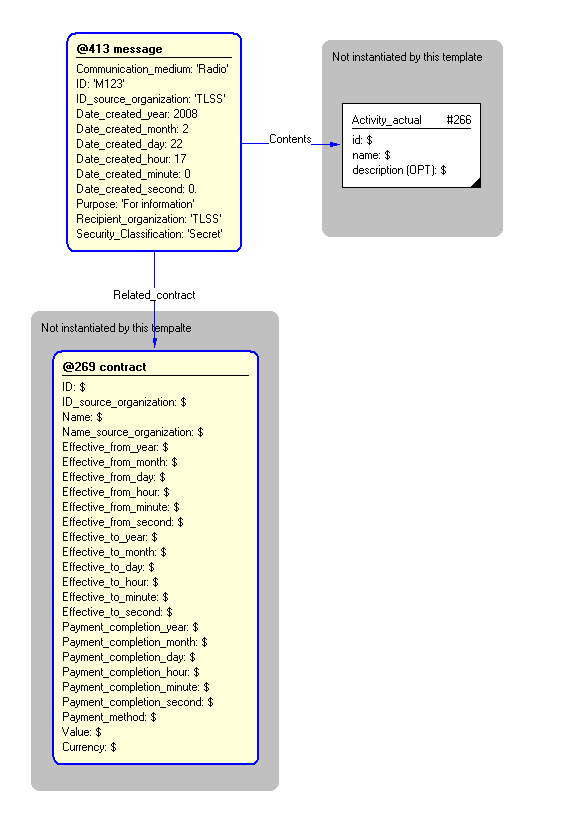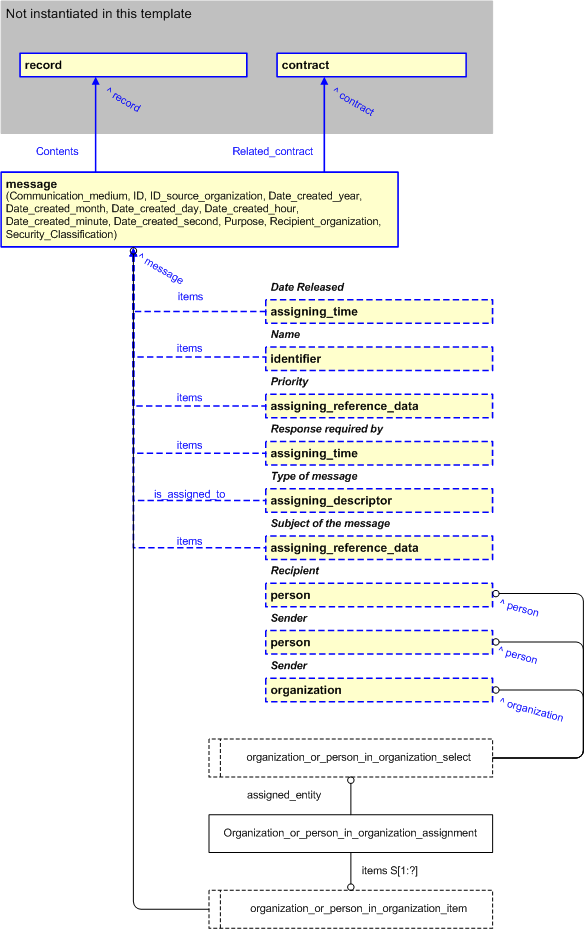Template:— message (msg)
Context:— UK_Defence |
Date: 2010/03/22 12:23:19
Revision: 1.4
|
This section specifies the template message.
NOTE
The template has been defined in the context of
UK_Defence.
Refer to the business context for details of related templates.
NOTE
An explanation of a template and the associated instantiation path is
provided in the
Template overview
section.
This template describes how to represent the UK_Defence concept of a message
in terms of PLCS model elements (templates, entities, and reference data).
The Message business object is used by those UK_Defence Data Exchange
Specifications that require information about communications between people and organizations.
Figure 1 — Graphical Representation for Business Object Message
Message:
The definition of a message object is:
Data about a messages that is intended to be communicated between people / organizations.
NOTE
This represents a basic message structure, that may be used for feedback messages, information item distribution etc.
|
Attribute name
|
Attribute description
|
Attribute type
|
Optionality
|
| Communication Medium |
This is the method by which the message is transmitted.
EXAMPLE
Radio, Channel 5, email.
|
Intrinsic |
Mandatory |
| Contents |
This is the reference to the records that may be contained within the message. |
Record |
Mandatory |
| Date Created |
This is the date on which the message was created. |
Intrinsic |
Mandatory |
| Date Released |
This is the date on which the message is sent. |
Intrinsic |
Optional |
| ID |
This is the identifier of the Message. |
Identifier |
Mandatory |
| Name |
This is the name of the Message. |
Intrinsic |
Optional |
| Priority |
This is the priority of the message. |
Intrinsic |
Optional |
| Purpose |
This is the purpose of the message. |
Intrinsic |
Mandatory |
| Recipients |
This is the reference to persons and/or organizations that receive the message. |
SELECT |
Mandatory |
| Related Contract |
This is the reference to the contract under which the message is exchanged. |
Contract |
Mandatory |
| Response Required By |
This is the date on which a response to the message is required from the recipients. |
Intrinsic |
Optional |
| Security Classification |
This is the security classification of the message. |
Intrinsic |
Mandatory |
| Sender |
This is the reference to the person and/or organization that sends the message. |
Person or Organization |
Mandatory |
| Subject |
This is the subject of the message |
Intrinsic |
Optional |
| Type |
This is the type of the message.
EXAMPLE
"comment",
"status change",
"routine communication",
"data import",
"data export",
"for comment",
"for review",
"for information",
"for approval".
|
Intrinsic |
Optional |
Table 1 — Message attribute details
The EXPRESS-G diagram in
Figure
2
shows the templates and EXPRESS entities that are required
to represent the template
"message".
The text highlighted in blue shows the template parameters.
Figure 2 — An EXPRESS-G representation of the Information model for message
The graphic for the template to be used in other EXPRESS-G diagrams
is shown in Figure
3
below.
Figure 3 — The graphical representation of the message template
The following input parameters are defined for this template:
The name of the class used to classify the
Message
with the medium used to communicate the data in the message.
The following classes and their sub-classes can be used:
classifications: [Message_communication_medium]![[warning:]](../../../../../../images/dex/warning.gif) Error RDL4: The URI urn:plcs:rdl:uk_defence is not listed in dexlib/data/refdata/rdl_index.xml
Error RDL4: The URI urn:plcs:rdl:uk_defence is not listed in dexlib/data/refdata/rdl_index.xml
The identifier of the message.
The identifier of the organization responsible for identifying the message .
Calendar_date year_component of the date that the message was created.
Calendar_date month_component of the date that the message was created.
Calendar_date day_component of the date that the message was created.
Local_time hour_component of the date and time that the message was created.
Local_time minute_component of the date and time that the message was created.
This parameter is optional. If not given, it will remain unset.
Local_time second_component of the date and time that the message was created.
This parameter is optional. If not given, it will remain unset.
Text that describes the purpose of the message.
The name or identifier of the receiving organization.
The following classes and their sub-classes can be used:
The content of the message.
The content of the message.
The following reference parameters are defined for this template:
Allow the
Message
entity instantiated in this path to be referenced when this template is used.
Note: The
Message
entity can be referenced in a template path by:
%^target = $message.message%
where
target
is the parameter to which the
Message
is bound.
Allow the
Contract
entity instantiated in this path to be referenced when this template is used.
Note: The
Contract
entity can be referenced in a template path by:
%^target = $message.contract%
where
target
is the parameter to which the
Contract
is bound.
The following parameter combinations specify a uniqueness constraint:
Unique constraint: Unique id
Each instance of the
entity
(
Message)
within the data set shall be uniquely identified
by a combination of the following parameters on this
template (message) namely:
ID,
ID_source_organization.
The
instance is
referenced by the following template parameter:
message.
The instantiation path shown below specifies the entities that are to be
instantiated by the template.
A description of templates and the syntax for the instantiation path is
provided in the
Templates Help/Information section.
-- Message /
representing_message(
rep_msg_id=@ID,
rep_msg_id_class_name='Message_identification_code',
rep_msg_id_ecl_id='urn:plcs:rdl:std',
rep_msg_id_owner=@ID_source_organization,
rep_msg_id_owner_class_name='Organization_name',
rep_msg_id_owner_ecl_id='urn:plcs:rdl:std',
date_class_name='Date_actual_creation',
date_ecl_id='urn:plcs:rdl:std',
year=@Date_created_year,
month=@Date_created_month,
day=@Date_created_day,
hour=@Date_created_hour,
minute=@Date_created_minute,
second=@Date_created_second,
sense='.EXACT.',
hour_offset='0',
minute_offset='0',
ap239_id_class_name='AP239_ed1_tc1_message',
ap239_id_ecl_id='urn:plcs:rdl:std',
dex_id_class_name='DEX_message_uk_defence',
dex_id_ecl_id='urn:plcs:rdl:uk_defence',
content=@Contents)/
%^message = $representing_message.message%
-- Purpose /
assigning_descriptor(
descr=@Purpose,
class_name='Purpose',
ecl_id='urn:plcs:rdl:uk_defence',
is_assigned_to=^message)/
-- Recipient (organization) /
assigning_organization(
org_id=@Recipient_organization,
org_id_class_name='Organization_name',
org_id_ecl_id='urn:plcs:rdl:std',
org_assgn_class_name='Receiver_of',
org_assgn_ecl_id='urn:plcs:rdl:std',
items=^message)/
-- Security classification /
assigning_security_classification(
security_class_name=@Security_Classification,
security_ecl_id='urn:plcs:rdl:uk_defence',
items=^message)/
-- Communication medium /
assigning_reference_data(
items=^message,
class_name=@Communication_medium,
ecl_id='urn:plcs:rdl:uk_defence')/
-- Contract reference Contract_assignmentContract_assignment.items ->
^message
Contract_assignment.assigned_contract ->
@Related_contract
The instance diagram in Figure
4
shows an example of the EXPRESS entities and templates that are instantiated by the template:
/message(receiver_organization='UK_Defence', contract_identifier='C123', extract_year='2007', extract_month='11', extract_day='27', extract_hour='16', extract_minute='14', extract_second='22', security_class='Secret', Communication_medium='Radio', ID='M123', Date_created_year='2008', Date_created_month='2', Date_created_day='22', Date_created_hour='17', Date_created_minute='0', Date_created_second='0', Sender_organization='Express Delivery Ltd', Purpose='For information', Recipient_organization='UK_Defence', Security_Classification='Secret', Contents='#266')/
(an illustration of the consolidated message template is shown in
Figure
5 below.)
Figure 4 — Entities instantiated by message template
The instance diagram in
Figure
5
shows the graphic symbol for the template that is to be
used in other instance diagrams. The example template is:
/message(receiver_organization='UK_Defence', contract_identifier='C123', extract_year='2007', extract_month='11', extract_day='27', extract_hour='16', extract_minute='14', extract_second='22', security_class='Secret', Communication_medium='Radio', ID='M123', Date_created_year='2008', Date_created_month='2', Date_created_day='22', Date_created_hour='17', Date_created_minute='0', Date_created_second='0', Sender_organization='Express Delivery Ltd', Purpose='For information', Recipient_organization='UK_Defence', Security_Classification='Secret', Contents='#266')/
Figure 5 — Instantiation of message template
The following section details how the
message
template can be optionally characterized by assigning
other constructs to it. These are characterizations commonly
applied to the template. The ISO 10303-239 EXPRESS model may enable
other assignments to the entities instantiated by the template.
The EXPRESS-G diagram in Figure
6
shows the possible characterizations of the template
"message".
Figure 6 — Characterizations for message
The following characterizations may apply:
Characterization Date released
NOTE this characterization is optional.
The date/time when a message is created is applied to the message using instances of
the template assigning_time.
This is applied to the ^message reference parameter.
See Figure 6 for the an abstract view of this.
The following template call shows how this might be instantiated with respect to Figure 5.
/assigning_time(date_class_name='Date_actual_release', date_ecl_id='urn:plcs:rdl:std', year='2008', month='01', day_in_month_number='30', hour='17', minute='0', second='0', sense='.EXACT.', hour_offset='0', minute_offset='0', items='@1')/
Characterization Name
NOTE this characterization is optional.
A name for the message is provided using instances
of the template assigning_identification.
These are applied to the ^message reference parameter. See Figure 6 for the an abstract view of this.
The following template call shows how this might be instantiated with respect to Figure 5.
/assigning_identification(id='The name of the message', id_class_name='Name', id_ecl_id='urn:plcs:rdl:std', org_id='UK_Defence', org_id_class_name='Organization_name', org_id_ecl_id='urn:plcs:rdl:std', items='@1')/
Characterization Priority
NOTE this characterization is optional.
Priorities can be applied to the message using instances of
the template assigning_reference_data.
This is applied to the ^message reference parameter. See Figure 6 for the an abstract view of this.
The following template call shows how this might be instantiated with respect to Figure 5.
/assigning_reference_data(class_name='Urgent', ecl_id='urn:plcs:rdl:std', items='@1')/
Characterization Recipient (person)
NOTE this characterization is optional.
The person who receives the message is recorded using instances of
the template UK_Defence.assigned_person.
This is applied to the ^message reference parameter. See Figure 6 for the an abstract view of this.
The following template call shows how this might be instantiated with respect to Figure 5.
/assigned_person(family_name='Brown', first_name='John', ID='JB001', source_organization='BAE Systems', type='Message_recipient', middle_name='', prefix_title='', suffix_title='', items='@1')/
Characterization Response required by
NOTE this characterization is optional.
The date/time when by which a response is required can be applied to the message using instances of
the template assigning_time.
This is applied to the ^message reference parameter.
See Figure 6 for the an abstract view of this.
The following template call shows how this might be instantiated with respect to Figure 5.
/assigning_time(date_class_name='Response_required_byt', date_ecl_id='urn:plcs:rdl:uk_defence', year='2008', month='01', day_in_month_number='30', hour='17', minute='0', second='0', sense='.EXACT.', hour_offset='0', minute_offset='0', items='@1')/
Characterization Sender (person)
NOTE this characterization is optional.
The person who sends the message is recorded using instances of
the template UK_Defence.assigned_person template and the
Organization_or_person_in_organization_assignment entity.
This is applied to the ^message reference parameter. See Figure 6 for the an abstract view of this.
The following template call shows how this might be instantiated with respect to Figure 5.
/assigned_person(family_name='Smith', first_name='John', ID='JS001', source_organization='BAE Systems', type='Message_Sender', middle_name='', prefix_title='', suffix_title='', items='@1')/
Characterization Sender (organization)
NOTE this characterization is optional.
The organization who sends the message is recorded using instances of
the UK_Defence.organization template and the
Organization_or_person_in_organization_assignment entity.
This is applied to the ^message reference parameter. See Figure 6 for the an abstract view of this.
The following template call shows how this might be instantiated with respect to Figure 5.
/organization(id='K0999', source_organization='BAE Systems', ID_type='Identification_code', name='BAE SYSTEMS', items='@1')/
Characterization Type
NOTE this characterization is optional.
The message type is provided using instances of the template assigning_reference_data.
These are applied to the ^message reference parameter. See Figure 6 for the an abstract view of this.
The following template call shows how this might be instantiated with respect to Figure 5.
/assigning_reference_data(class_name='Routine_communication', ecl_id='urn:plcs:rdl:uk_defence', items='@1')/
Characterization Assigning subject
NOTE this characterization is optional.
The subject of the message can be provided using instances
of the template assigning_descriptor.
These are applied to the ^message reference parameter. See Figure 6 for the an abstract view of this.
The following template call shows how this might be instantiated with respect to Figure 5.
/assigning_descriptor(descr='This describes the transmission method for the message', class_name='Message_transmission_method', ecl_id='urn:plcs:rdl:uk_defence', is_assigned_to='@1')/
